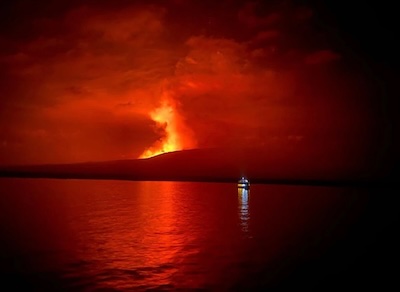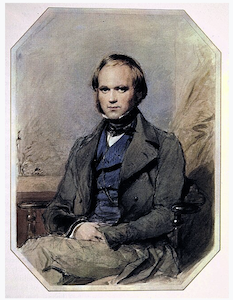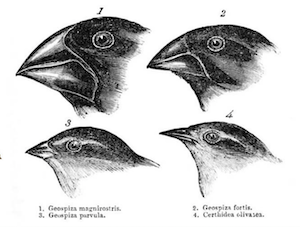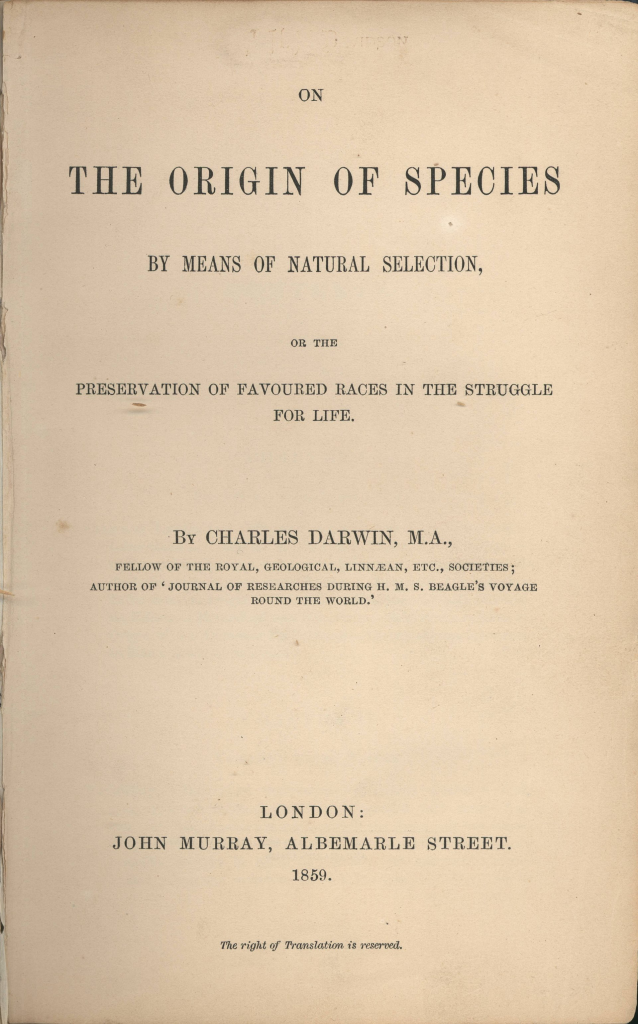
A hot spot is a weakness in the Earth’s mantle where magma can break through and possibly form a volcano. Such a hot spot exists on the Nazca tectonic plate located just off the western coast of South America, and this hot spot is responsible for the creation of the Galápagos Islands. As the Nazca tectonic plate has moved southeast over the hot spot, new islands formed in the west while older islands drifted southeast and eroded over millions of years.
The ages of the islands vary from estimates of 4½ million years in the southeast to less than a million years for Fernandina, the newest island in the west. There may be older islands that have completly eroded and are now underwater, and there are likely to be new islands that do not yet exist.
As the photo indicates, Fernandina has an active volcano. With lava flowing to the sea, the island is still growing.
New islands begin as a barren, lifeless mass of lava and rock. Over thousands to millions of years, they can become fertile and lush through a slow but remarkable sequence of ecological processes. Fernandina is still largely volcanic and barren, but it already has Lava cactus growing in cracks and mangroves along the coast, with Marine Iguanas, birds, and insects contributing nutrients to developing soil.
Arrival of Life
The earliest colonizers would have been wind-dispersed or water-dispersed plant seeds, as well as spores from ferns and mosses. Plant seeds may also have arrived on floating vegetation rafts, created from trees and plants torn from the ground and swept by rivers to the sea during extreme flooding on the mainland. Many seeds may have sprouted, some may have failed, but seeds are still arriving in the same way.
The arrival of animal species in the Galápagos Islands also happened gradually over millions of years. Because the islands were never connected to the mainland, every species had to arrive via long-distance dispersal — by air, sea, or mats of floating vegetation.
Birds arrived at various times over last 2–3 million years, and they could still be arriving. Birds are known to carry undigested seeds in their stomachs. Seeds can also stick to their plumage and to muddy feed. So what arrived first, seeds or birds? Perhaps it was at the same time.
A non-flying bird, the Galápagos Penguin, likely arrived from southern South America via the Humboldt and Cromwell Currents, about 1–2 million years ago.
Another bird, possibly the double-crested cormorant found along the Pacific coast of North America, arrived about 2 million years ago. For the last few hundred thousand to a million years or so, the cormorants in the Galápagos have had stubby wings, and have been unable to fly.
Reptiles, including the tortoise, iguanas, and lizards, are thought to have arrived ~2–5 million years ago on rafts of vegetation. With skin covered in scales that resist drying, being cold-blooded, and requiring little food or water, reptiles were ideal candidates for a long accidental voyage.
The Marine Iguana in the Galápagos today is now the only iguana in the world that swims, dives, and feeds unerwater.
Although Central and South America have a diverse range of frogs, not a single amphibian naturally found its way to the Galápagos. Their skin must remain wet, and they could not survive two weeks in the equatorial sun. Falling into salt water would be lethal.
Adaptation Through Natural Selection and Darwin
The animals that were lucky or unlucky enough to make it to the Galápagos Island alive may have found the conditions such that they could not survive, and this may have depended on which animal and on which island they landed, and when. Many animals that found a way to survive in their new home faced either hostile or at least challenging environments. Some had to adapt to an environment different from the one from where they came, or die.

Charles Darwin joined the HMS Beagle in 1831 as a naturalist and companion to Captain Robert FitzRoy. He was 22 years old at the beginning of the voyage, and he had just finished studying theology at Cambridge University, though his real passion was natural history. The purpose of the Beagle’s voyage was to survey and chart the coasts of South America, update naval maps, and conduct scientific and geologic exploration.
The ship stopped in the Galápagos Islands from September to October, 1835, visiting six islands during their five-week stay. During his exploration, Darwin focused on three activities:
- Collecting specimens – fossils, plants, animals which he later studied and documented.
- Observing the unique behaviors and physical characteristics of the islands’ species, noting how they varied from one island to another.
- Recording his observations in great detail, noting environmental conditions, species differences, and geological features.
After returning to England at the end of the voyage in October 1836, other than starting a family resulting in ten children and dealing with some health issues, be began extensive research using his notes to guide him. He engaged in ongoing correspondence with other naturalists and scientists to answer questions and improve his understanding of the relevant sciences.
As one example, Darwin sent many of the bird specimens he collected in the Galápagos Islands to John Gould, a prominent British ornithologist and illustrator. Darwin labeled his specimens as finches, mockingbirds, warblers, wrens, and others based on beak shapes and sizes. Gould, however, identified the specimens as separate species of finches, highlighting their variations in beak shape and size. Darwin accepted his mistake and realized that the variation among finch species across islands supported the idea of a species adapting to different environments. But how could this happen?
Darwin knew that traits (visible traits in his time such as beak shape, color, & size in birds) were passed to offspring from parents. He also understood there was a variety of traits within every population of organisms.
Darwin’s data led to his conclusion that these trait changes over time allow an organism to adapt to changing environment.
Here is how adaption works step by step given modern day knowledge:
- Variation already exists in a population due to random genetic mutations and recombination during reproduction.
- An environmental change occurs — this could be climate change, a new predator, a shift in available food sources, disease, etc.
- Some individuals in the population may already have beneficial traits (due to earlier trait variation) that make them better suited to the new environment. If the environment changes but no individuals have beneficial traits, the population may decline sharply, migrate if possible, or face extinction.
- The individuals who have beneficial traits are more likely to survive and reproduce, passing on their advantageous traits to offspring.
- The individuals without the beneficial traits may die, or at least become an ever-smaller part of the population.
- Over time, those beneficial traits become more common in the population — this is evolution explained by natural selection.
The environmental change comes first, and natural selection acts on existing variation. Traits don’t evolve “in anticipation” of future changes. Evolution has no foresight — it’s reactive, not proactive.

If trait changes driven by environmental pressure become significant enough, an organism can evolve into a new species that usually can no longer breed with the former species to create fertile offspring. This process is called speciation, and it’s a key outcome of evolution by natural selection.
Another term, “adaptive radiation” is like speciation but done “rapidly”. It is driven by new environments (such as an island, or a different volcanos on the same island) followed by natural selection. Instead of one species evolving into two species, perhaps because of reproductive isolation, adaptive radiation will give rise to many species from one. Adaptive radiation is what happened in the Galápagos with finches, tortoises, mockingbirds, and some plants.
In the Galápagos Islands, there are many endemic species. In biology “endemic” refers to a species that is native to and restricted to a specific geographic area, meaning it is not found naturally anywhere else in the world. As already mentioned, since animals first settled in the Galápagos, many faced environmental changes. Evolution through natural selection together with speciation explains the origin of many endemic species found in the Galápagos Islands. It explains how a cormorant became flightless, or how an iguana became a swimmer.
An example of adaptive radiation is one finch species “quickly” evolving into fourteen different species. Finches likely spread to multiple islands, each with different climates, vegetation, and food sources. Once on separate islands, populations became geographically isolated, and with limited gene flow between islands, these groups began to evolve independently. Some species now coexist on the same island but in different ecological niches.

Finally, in 1859, twenty-three years after returning from the Galapagos, Darwin finally published On the Origin of Species by Means of Natural Selection, or the Preservation of Favoured Races in the Struggle for Life.
He feared backlash from his conclusions, so an irrefutable scientific case before going public was needed. This required a lot of research and scientific collaboration. Darwin also understood that his theory challenged religious beliefs about the creation of life, and he once described publishing the theory as like “confessing to a murder.” Darwin wanted to anticipate and address these potential objections before publication.
The final push to publish, however, was a similar theory independently developed by another naturist, Alfred Russel Wallace. Darwin, a scientific perfectionist, wanted to ensure that he was recognized as the originator of the theory of natural selection.
Darwin was on the right track about natural selection, but his theory was incomplete due to the scientific limitations of his era. Unfortunately, he did not know about Gregor Mendel’s work — even though Mendel’s experiments on heredity were published during Darwin’s lifetime. Had he known about Mendel’s clear, mathematical work on dominant and recessive traits, it might have helped him greatly in explaining variation and inheritance — key elements of evolution by natural selection.
The discovery of DNA in 1953 revealed the molecular structure behind heredity and mutation. This allowed scientists to trace evolutionary relationships through genetic sequencing, something Darwin could never have imagined.
In summary, natural selection is a robust scientific theory developed and improved over decades that explains how evolutionary changes occur in populations over time. It is a foundational concept in biology that is supported by a wealth of evidence, making it a critical component of our understanding of evolution.
